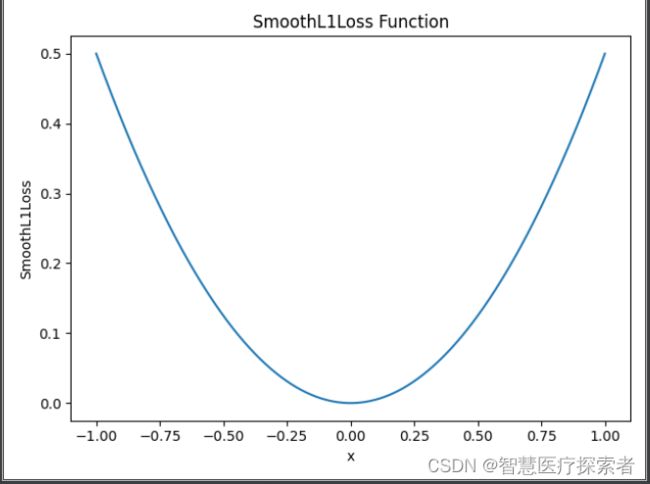pytorch中常用的损失函数
1 损失函数的作用
损失函数是模型训练的基础,并且在大多数机器学习项目中,如果没有损失函数,就无法驱动模型做出正确的预测。 通俗地说,损失函数是一种数学函数或表达式,用于衡量模型在某些数据集上的表现。损失函数在深度学习主要作用如下:
- 衡量模型性能:损失函数用于评估模型的预测结果与真实结果之间的误差程度。较小的损失值表示模型的预测结果与真实结果更接近,反之则表示误差较大。因此,损失函数提供了一种度量模型性能的方式。
- 参数优化:在训练机器学习和深度学习模型时,损失函数被用作优化算法的目标函数。通过最小化损失函数,可以调整模型的参数,使模型能够更好地逼近真实结果。
- 反向传播:在深度学习中,通过反向传播算法计算损失函数对模型参数的梯度。这些梯度被用于参数更新,以便优化模型。损失函数在反向传播中扮演着重要的角色,指导参数的调整方向。
- 防止过拟合:过拟合是指模型在训练数据上表现良好,但在新数据上表现较差的现象。损失函数可以帮助在训练过程中监控模型的过拟合情况。通过观察训练集和验证集上的损失,可以及早发现模型是否过拟合,从而采取相应的措施,如正则化等。
2 pytorch中常见的损失函数
| 损失函数 | 名称 | 适用场景 |
|---|---|---|
| torch.nn.MSELoss() | 均方误差损失 | 回归 |
| torch.nn.L1Loss() | 平均绝对值误差损失 | 回归 |
| torch.nn.CrossEntropyLoss() | 交叉熵损失 | 多分类 |
| torch.nn.NLLLoss() | 负对数似然函数损失 | 多分类 |
| torch.nn.NLLLoss2d() | 图片负对数似然函数损失 | 图像分割 |
| torch.nn.KLDivLoss() | KL散度损失 | 回归 |
| torch.nn.BCELoss() | 二分类交叉熵损失 | 二分类 |
| torch.nn.MarginRankingLoss() | 评价相似度的损失 | |
| torch.nn.MultiLabelMarginLoss() | 多标签分类的损失 | 多标签分类 |
| torch.nn.SmoothL1Loss() | 平滑的L1损失 | 回归 |
| torch.nn.SoftMarginLoss() | 多标签二分类问题的损失 | 多标签二分类 |
2.1 L1损失函数
预测值与标签值进行相差,然后取绝对值,根据实际应用场所,可以设置是否求和,求平均,公式可见下,Pytorch调用函数:nn.L1Loss
import torch
import torch.nn as nn
Loss_fn = nn.L1Loss(size_average=None, reduce=None, reduction='mean')
input = torch.randn(3, 5, requires_grad=True)
target = torch.randn(3, 5)
output = Loss_fn(input, target)
print(output)运行结果显示如下:
tensor(1.4177, grad_fn=) 2.2 L2损失函数
预测值与标签值进行相差,然后取平方,根据实际应用场所,可以设置是否求和,求平均,公式可见下,Pytorch调用函数:nn.MSELoss
import torch.nn as nn
import torch
loss = nn.MSELoss(size_average=None, reduce=None, reduction='mean')
input = torch.randn(3, 5, requires_grad=True)
target = torch.randn(3, 5)
output = loss(input, target)
print(output)运行结果显示如下:
tensor(1.7956, grad_fn=) 2.3 Huber Loss损失函数
简单来说就是L1和L2损失函数的综合版本,结合了两者的优点,公式可见下,Pytorch调用函数:nn.SmoothL1Loss
import matplotlib.pyplot as plt
import torch
# 定义函数和参数
smooth_l1_loss = nn.SmoothL1Loss(reduction='none')
x = torch.linspace(-1, 1, 10000)
y = smooth_l1_loss(torch.zeros(10000), x)
# 绘制图像
plt.plot(x, y)
plt.xlabel('x')
plt.ylabel('SmoothL1Loss')
plt.title('SmoothL1Loss Function')
plt.show()运行结果显示如下:
2.4 二分类交叉熵损失函数
简单来说,就是度量两个概率分布间的差异性信息,在某一程度上也可以防止梯度学习过慢,公式可见下,Pytorch调用函数有两个,一个是nn.BCELoss函数,用的时候要结合Sigmoid函数,另外一个是nn.BCEWithLogitsLoss()
import torch.nn as nn
import torch
m = nn.Sigmoid()
loss = nn.BCELoss()
input = torch.randn(3, requires_grad=True)
target = torch.empty(3).random_(2)
output = loss(m(input), target)
print(output)运行结果显示如下:
tensor(0.6214, grad_fn=) import torch
import torch.nn as nn
label = torch.empty((2, 3)).random_(2)
x = torch.randn((2, 3), requires_grad=True)
bce_with_logits_loss = nn.BCEWithLogitsLoss()
output = bce_with_logits_loss(x, label)
print(output)运行结果显示如下:
tensor(0.7346, grad_fn=) 2.5 多分类交叉熵损失函数
也是度量两个概率分布间的差异性信息,Pytorch调用函数也有两个,一个是nn.NLLLoss,用的时候要结合log softmax处理,另外一个是nn.CrossEntropyLoss
import torch
import torch.nn.functional as F
input = torch.randn(3, 5, requires_grad=True)
target = torch.tensor([1, 0, 4])
output = F.nll_loss(F.log_softmax(input, dim=1), target)
print(output)运行结果显示如下:
tensor(2.9503, grad_fn=) import torch
import torch.nn as nn
loss = nn.CrossEntropyLoss()
inputs = torch.randn(3, 5, requires_grad=True)
target = torch.empty(3, dtype=torch.long).random_(5)
output = loss(inputs, target)
print(output)运行结果显示如下:
tensor(1.6307, grad_fn=) 2.6 自定义损失
通过对 nn 模块进行子类化,将损失函数创建为神经网络图中的节点。 这意味着我们的自定义损失函数是一个 PyTorch 层,与卷积层完全相同。
class Custom_MSE(nn.Module):
def __init__(self):
super(Custom_MSE, self).__init__();
def forward(self, predictions, target):
square_difference = torch.square(predictions - target)
loss_value = torch.mean(square_difference)
return loss_value
# def __call__(self, predictions, target):
# square_difference = torch.square(y_predictions - target)
# loss_value = torch.mean(square_difference)
# return loss_value可以在“forward”函数调用或“call”内部定义损失的实际实现。
3 总结
损失函数在人工智能领域中起着至关重要的作用,它不仅是模型训练和优化的基础,也是评估模型性能、解决过拟合问题以及指导模型选择的重要工具。不同的损失函数适用于不同的问题和算法,选择合适的损失函数对于取得良好的模型性能至关重要。




